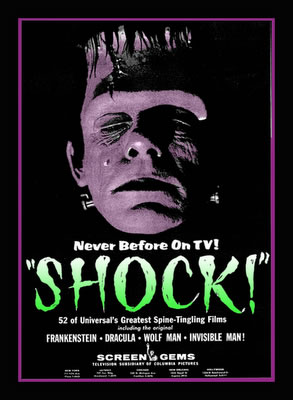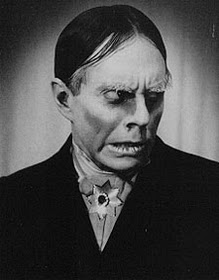 Professor Kinema (Jim Knusch) shares his ghoul-times growing up as a Dr. Denton’s attired Monsterkid, his discovery of Shock Theater, and his ongoing passion for fantastic cinema, horror hosts, and monster magazines. Along the way, he picks some bones to rattle in the closet, contributes to the first Horror-Thon in New Jersey, and talks about the Zacherley fan clubs. (Those rattling noises you hear may sound familiar.)
Professor Kinema (Jim Knusch) shares his ghoul-times growing up as a Dr. Denton’s attired Monsterkid, his discovery of Shock Theater, and his ongoing passion for fantastic cinema, horror hosts, and monster magazines. Along the way, he picks some bones to rattle in the closet, contributes to the first Horror-Thon in New Jersey, and talks about the Zacherley fan clubs. (Those rattling noises you hear may sound familiar.)
Copies of what’s housed in Professor Kinema’s Archives, whether they be DVDs of video material, CDs of audio material, or reproductions of any and all printed material (stored on discs, flash drives or hard copy printouts) can be made available to the serious researcher. Specific listings can be provided along with proper arrangements.
A strong early childhood memory of mine is lying in bed, wide awake, listening to the muted sounds of the TV set in the living room. Dim light patterns were visible on the hallway wall just outside of my bedroom door, changing with the muted sounds. Naturally I wondered what these sounds and shadow plays looked like after my bed time.
Earlier in the day, up until bed time, I was allowed to view what one of my teachers referred to as ‘the one-eyed monster.’ This consisted of kid’s and family programming I could identify with. What was being broadcast after I was sent to bed became very mysterious. I posited that one of the acquired privileges of being a ‘grown-up’ meant that one could stay up as late as they wanted and watch TV.
Eventually, on Friday and Saturday nights, I was allowed to stay up late and see what the tube had to offer. Sitting there in my Dr. Denton’s (yes, one button was always undone) I discovered that what I was imagining to come over the TV airwaves was a bit different from what I was viewing. It was ‘grown-up stuff’ that I found I didn’t really understand and wasn’t interested in. But wait! Later at night, after the news and weather, came something unique…vintage monster movies. My two younger brothers usually bailed out by this time and went to bed. The only light in the living room came from the TV. Now the shadows were happening all around me. The sounds were low, but sharper. No one else in the household found such fare interesting so my next strong childhood memories consist of sitting by myself, enjoying the exploits of all sorts of grotesqueries that included Frankenstein, Dracula, the Wolf Man and the Mummy. Here in the late 1950s a Monsterkid was born.
This Monsterkid still sits up late at night, alone, watching vintage monster movies.
In the household, I was the one, albeit self-appointed, who was mainly responsible for getting the best signal on the TV. Cable, or ‘pay TV,’ was an entity not even heard of at this time. The roof antenna was of a bargain basement variety type, made of cheesy, easily breakable aluminum. Pointed in one direction, the airwaves from the west, from New York City, came in the strongest. Pointed more toward the North, the few stations from the nether regions of Connecticut, ‘across the pond (the Long Island Sound)’ from our residence on Long Island, came in stronger. Late Friday and Saturday nights, the horror films permeated the airwaves, beaming in from Connecticut.
Naturally, I was the only one willing to climb up on the roof to position the antenna. My kid brother, by no real fault of his own, was very little help in determining what the best signal was. He would yell back to me, “Yea, that’s the best picture!” But when I climbed back down he would announce, “It was really better before,’ and so on…ad nauseum. To be able to settle in and enjoy a late night’s fare of grainy B&W, flickering iconoscopic fantasma, and be an accomplished Monsterkid, I had to shift for myself.
By the 5th grade it was ‘cool’ to discuss what we were watching on TV, as well as what we went to see in the movies. Monster movies usually dominated the conversation. The exploits of the current monster movies (the ones that parents let their kids see, or simply didn‘t care) were usually culled from Saturday afternoon ‘kiddie matinees.’ The topics of the more vintage ones was from the fare I discovered late on Saturday and (sometimes) Friday nights.
One day a classmate said to me, “You ought to check out this man who just started on TV on Saturday night. He looks like a monster, but he’s funny.” This piqued my interest. That next Saturday night I tuned in and discovered Shock Theater (marketed as Shock!) and it’s bizarre host…Zacherley. Yes, he definitely looked like a monster, but he was most assuredly funny. For the remainder of 5th grade, talk always included the most recent TV escapades of Zacherley.
 Shock! had existed in the New York area in the 1957-58 season, but sans host. By the beginning of the 1958-59 season (Son of Shock!) , scores of horror host fan clubs had materialized around the country. Zacherley, who had been hosting Shock! on WCAU in Philadelphia as ‘Roland’ (accent on the second syllable), had the most fan clubs of all the Horror Hosts who were haunting the airwaves. Because of this popularity he was invited, with an increase in salary, to haunt the airwaves of New York City (on WABC).
Shock! had existed in the New York area in the 1957-58 season, but sans host. By the beginning of the 1958-59 season (Son of Shock!) , scores of horror host fan clubs had materialized around the country. Zacherley, who had been hosting Shock! on WCAU in Philadelphia as ‘Roland’ (accent on the second syllable), had the most fan clubs of all the Horror Hosts who were haunting the airwaves. Because of this popularity he was invited, with an increase in salary, to haunt the airwaves of New York City (on WABC).
Fading in with an accompanying wolf howl, the show would begin, framed on some close-up section of the set. This was often a flickering candle, hypodermic needle, or skull–usually covered with cobwebs. To our sensibilities this was the ‘house of Zacherley.’ Strange things were hanging on the walls and occasional strange sounds were coming from somewhere off screen.
The camera would pan either right or left to frame Zacherley actively involved in some sort of bizarre activity. At this time he would then notice the viewer and speak directly to the camera with a cheery, “Hello! Zacherley here!” and give some sort of explanation as to what he was up to. One got the impression that he lived in these surroundings with cameras all around, poised and ready to go 24/7. At this particular time of the week these cameras would suddenly turn on to catch whatever he was doing at that time. Accordingly, when the show ended, he would continue with his bizarre activities until next week, when the cameras would reactivate and we, the viewers, would again visit via the magical realm of TV.
When the week’s movie began, the anticipation became high: when was he going to be briefly seen during the movie’s run? Eyes were glued to the screen, eagerly awaiting that moment. He didn’t disappoint. After the commercial break he was back in his usual surroundings, making a few off-the-cuff comments about the movie and continuing with the bizarre activity. His standard closing at the end of every show was the memorable, “Goodnight, whatever you are!” I, as well as tens of thousands of other viewers, had never seen anything like him. He was unique, he was bizarre, he was funny, he was entertaining. Therein is the essence of his cult status.
…
Professor Kimena’s Monster Kid ReflectionsRead More »
. ZC Rating: 5 of 7 (Excellent)
